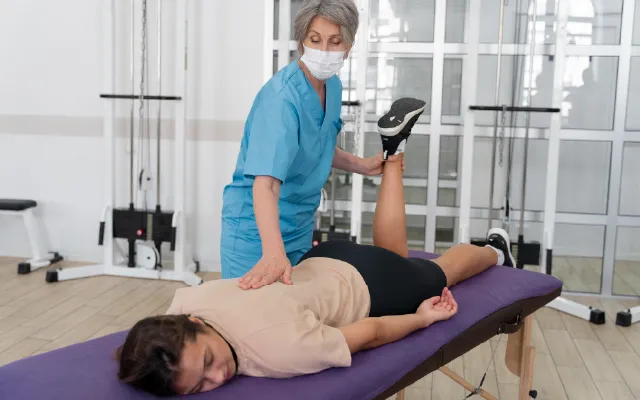
Musculoskeletal pain is damage to the body's bones, joints, muscles, ligaments, and tendons. Many things, such as accidents, physical activity, or vice versa can cause these injuries. Understanding the causes, symptoms, and treatment options for musculoskeletal disorders is important for physicians and individuals who want to prevent or manage these injuries. Let's examine the different musculoskeletal injuries to provide an overview. Significant advances have been made in the treatment of musculoskeletal trauma in recent years, transforming trauma by changing the way patients recover from trauma. Medical clinics play an important role in this process, offering a variety of specialized treatments and therapies tailored to each patient's unique needs.
Causes of Musculoskeletal Pain
musculoskeletal disorders and traumas can occur for various reasons. Events such as falls,
motorcycle accidents, or workplace accidents often result in broken bones, joints, or muscles.
Sports-related injuries also occur, especially in contact sports or repetitive or high-impact
activities. Additionally, overuse or repetitive injuries can cause musculoskeletal pain, especially
in people whose tasks are repetitive or require prolonged physical labor.
The causes of musculoskeletal pain may vary depending on age group. and certain activities
are included. For example, children and young people may develop osteoporosis as their bones
grow, while adults may develop osteoporosis due to conditions such as osteoporosis because
their bones are weak.
Symptoms of Musculoskeletal Trauma
Symptoms of musculoskeletal disorders and trauma can vary depending on the injury and the
area involved. Symptoms include pain, swelling, limited range of motion, deformity, and weight
gain. In more severe cases, open sores, bleeding, or visible bone deformations may occur. It's
important to remember that some injuries, such as stress fractures or ligament sprains, may
have mild symptoms but gradually worsen over time.
People with musculoskeletal injury may also experience tenderness, bruising, or numbness
around the injured area. If any of these symptoms occur, immediate treatment is important
because proper diagnosis and treatment can slow the healing process and reduce the risk of
problems for a long time.
Diagnosis and evaluation
Diagnosis of bone injuries is usually a combination of physical examination, visual examination,
and history. The doctor will examine the injured area for signs of swelling, deformity, or
tenderness. They may also perform special maneuvers or stress tests to evaluate joint stability
or ligament integrity.
Imaging tests such as X-rays, CT scans, or MRIs are necessary to further evaluate the injury.
While X-rays are often used to identify fractures and fractures, CT scans and MRIs provide
more detailed images of tissues, including muscles, tendons, and ligaments. These diagnostic
tools help develop the correct treatment plan and understand the severity of the pain.

Treatment Options for Musculoskeletal Disorders
Treatment of musculoskeletal injuries depends on the specific injury, its severity, and individual
factors such as age and general health. In less common cases, treatment methods including
rest, ice, compression and elevation (RICE), pain medication, and physical therapy may be
used.
Nonsteroidal anti-inflammatory drugs (NSAIDs) can be used to control pain and reduce
inflammation. The recommended medication for chronic musculoskeletal pain is Tapentadol
(Nucynta). Tapentadol is a drug notable for its ability to treat musculoskeletal pain. It is in a
class
of medications called opioid analgesics, which reduce pain by binding to certain receptors in the
brain and spinal cord.
More serious injuries may require surgery to straighten the bone, repair damaged ligaments or
tendons, or stabilize the joint. Surgery may involve the use of pins, screws, plates, or rods to
hold the broken bone in place during the healing process.
Post-care rehabilitation and physical therapy are important parts of the recovery process. These
programs are designed to restore strength, improve range of motion, and improve work
capacity. Rehabilitation may include exercise, stretching, manual therapy, and heat or cold
therapy.
Preventing musculoskeletal injury plays an important role in maintaining overall musculoskeletal health and reducing the risk of injury. Here are some tips that may help you:
- Wear protective clothing and appropriate equipment during high activity or high-pressure work.
- Use proper technique and form when performing physical work and lifting heavy objects.
- Gradually increase intensity and duration to avoid overuse injury.
- Take regular breaks to rest and stretch during long physical activities.
- Maintain good health and lifestyle to support bone and muscle health.
- Participating in regular strength and flexibility exercises strengthens muscles and improves coordination.
Recovery and Rehabilitation
The healing and recovery process after a musculoskeletal injury will vary depending on the type
and severity of the injury. A treatment plan should be followed, including recommended
treatments or rehabilitation.
During the recovery period, individuals should gradually resume physical activity and watch for
signs of pain or discomfort. It is important to communicate with your doctor throughout the
process to ensure reasonable progress and make appropriate adjustments to your treatment
plan.

